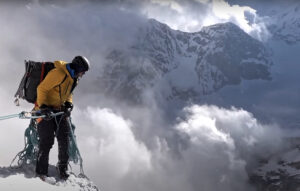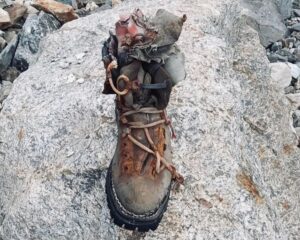The discovery of the body of British hiker Esther Dingley near Port de la Glere, a mountain pass on the French-Spanish border, has shocked the village of Benasque in the heart of the Pyrenees.
Dingley, 37, had been missing since November 22, 2020 after failing to show up after a solo hike. A trail runner on the French side found the first trace of her on July 30. Daniel Colegate, Dingley’s boyfriend, found the rest of her remains nearby on August 9. He had been searching for her for months.
Mystery at the Pyrenees’ Chamonix
The villagers, mountain guides, and rescue services from the Guardia Civil (among the best in Europe) are all-too-familiar with mountain accidents and rescues. Benasque is known as the Spanish Chamonix because of its charming alpine setting and atmosphere. Downhill and cross-country skiers flock to its resorts in winter, while mountain bikers and hikers dominate the summer. The area has the highest concentration of 3,000’ers in the Pyrenees.
Among them is Mount Aneto, the highest peak in the range and therefore a coveted trophy for thousands of climbers, ski mountaineers, hikers, and (sometimes not-so-well prepared) tourists. Large numbers of people with wildly different abilities also make it a hotspot for accidents. On the weekend of August 14-15, for example, the Guardia Civil in Benasque performed 21 rescues.
But this case was different. First, no trace of Dingley had turned up for such a long time, despite the efforts of specialized rescue patrols from both sides of the border.
Second, the cheerful British hiker had been hiking around Benasque for a while and met quite a few locals. When she vanished on a beautiful autumn Sunday in November, her van remained parked in Benasque. After the SOS call went out, many hikers and climbers called the police to report that they had bumped into her in the mountains.
“I met her twice while I hiked with my dog,” Noemi Alonso, a biologist who lives in Benasque, told ExplorersWeb. “Last time, we met at the Santa Ana’s Cabin [an open hut without a caretaker], where she spent the night. She told me she was headed for Salvaguardia Peak and asked the best way to reach the summit.”
The biologist found her cheerful and good company. “[She seemed] well-equipped and fit,” Alonso said. About whether she might be depressed or sad, per some local rumors, Alonso replied, “Absolutely not! She looked very happy and motivated to me.”

Esther Dingley was a lively, cheerful young woman who loved the mountains. Photo: LBT Global/Dingley’s family
If anything, she was overly motivated, as some local climbers who had also met her pointed out. She expressed interest in joining them on climbing trips, but they kindly discouraged her because she lacked the necessary equipment.
It all began at Salvaguardia’s summit
The last people to see Dingley alive were some descending hikers. She was on her way up 2,736m Salvaguardia (in French, Pic de Sauvegarde) at around 3 pm. At 4 pm, she sent her boyfriend, Daniel Colegate, a selfie from the summit. Then the news stopped.
At that time of the year, the sun sets at 6 pm. It is not confirmed whether she intended to retrace her steps back to Benasque or continue her tour by entering French territory. However, the place where her body lay made it obvious that she crossed the border after summiting Salvaguardia.
The most obvious way to do that is to enter France by the Portillon de Benasque, a mountain pass. She then wandered west on the French side, in order to return to Spain (and her van) via another pass: the Port de la Glere (Puerto de la Glera).

The view toward the Port de la Glere from the summit of Salvaguardia. Photo: Angela Benavides
The search began within 48 hours, after Daniel Colegate worriedly reported that his girlfriend had not checked in. Police in both France and Spain jointly searched the area with helicopters and on foot, using sniffing dogs. But they found no trace of Dingley, which puzzled everyone.
Some days later, snow covered the area and remained there until May 2021. The search ended, but rumors started to swirl.
Lack of news feeds rumors
Daniel Colegate soon traveled to the area and started looking himself. He couldn’t understand how she could have just disappeared.
“Esther is an experienced hiker who was carrying suitable equipment in terrain that would not have been a challenge to her,” he wrote at the time. “She had completed countless similar hikes successfully in the past, never leaving trails and being well aware of her body’s needs and limitations. If she suffered an accident, for whatever reason, I firmly believe she would have been found on or close to one of the extensive, well-made paths in the area.”
Soon, Colegate and Dingley’s family started mentioning abduction as a possibility. Worse, some media pointed to Colegate himself as a suspect. The police had questioned him in depth, they suggested.
Rumors also circulated in the village that the fairy-tale relationship between the two wanderers might be not at its best. Allegedly, one of them (Colegate) wanted to settle down, while Dingley longed to continue the vagabond life.
Eventually, the non-profit LBT Global, which spoke on behalf of the family, stated “that Daniel Colegate has not been ‘quizzed at length’ by police.”
In fact, whenever someone has been missing for days, investigators pursue all avenues, including questioning everyone close to the subject. But in the case of Colegate, he was the first to go to the police and share everything he knew. He cooperated at all times, walked over 1,000km searching for her, and never stopped thanking officials from both countries who took part in the search.

Tracks of all the routes Daniel Colegate walked in search of his missing fiancée. Photo: Esther and Dan’s Facebook blog
A grisly discovery
Months went by, and the snow receded. It still took over two months to find a trace of Dingley. At the end of July, a trail runner found a bone near Port de la Glere. It is usually hard to tell the difference between an animal and a human bone, except for a single piece. This was exactly what made the runner call the police immediately: It was a human skull, with some hair attached.
DNA tests proved it was Dingley’s. But there remained more questions than answers. Where were the rest of the body and her belongings? Why had no trace had turned up in this popular hiking region until now?
Colegate himself eventually solved some of the uncertainty. After the discovery of that one bone, he resumed his search. A week later, he found the rest of her body and most of her belongings, including clothes, cell phone, and her bright yellow sleeping mat.
Since she was on the French side, the Gendarmerie took charge of the subsequent investigation and took her remains to Toulouse for an autopsy.
The usual suspect
In the meantime, the general opinion was that animals had moved the remains. El Periodico de Aragon went beyond that and speculated that a bear might have attacked the unfortunate hiker.
That hypothesis is far-fetched. “Right now there’s only one confirmed bear in the area and its territory is quite far away, in the Chistau Valley,” Noemi Alonso said. “Also, brown bears rarely attack humans.”
Indeed, bears in the Pyrenees are both scarce and extremely shy. We have found reports of only one attack in the Pyrenees, back in 2008. Cattle are a different story, and a heated debate continues between conservationists and local villagers. “Goiat”, the Chistau Valley bear, is particularly contentious. It moves through huge territories, often feeding on sheep, cows, goats, and foals.

Goiat, the bear from the Chistau Valley, close to Benasque.
France reintroduced bears from Slovenia in 1996-97 into its side of the Pyrenees. But many of them seemed to prefer the sunnier Spanish side and moved over there. Since then, arguments arise every time an animal kills cattle or a bear is shot, either in self-defense or because it is allegedly mistaken for a wild boar.
Official conclusions
So what happened?
Sadly, fatal falls are common in mountains around the world. In the Pyrenees, in particular, there is a noticeable difference between the Spanish side to the south and the French side, which is usually more humid, greener, and therefore slippery.
The area where the accident took place lies between two mountain passes: the narrow Portillon de Benasque (in French, Port de Benasque), a crack in the rock wall on the eastern flank of Salvaguardia, and the Port de la Glere to the west.
In summer and fall, the rocky terrain and dried-out pastures on the Spanish side change dramatically on the French side. Here, green slopes plunge steeply down toward the charming, slightly decadent town of Bagneres-de-Luchon, nearly 2,000 vertical metres below.
These passes have a chequered history: They were used by merchants and smugglers in the 18th and 19th centuries; then by early mountaineers; and later, by refugees during the Spanish Civil War and World War II. They are now popular paths for hiking and long-distance trail races.
For Esther Dingley, Portillon de Benasque was an obvious pass to cross to the north. She probably planned to hike along the French side and then head west in order to return by Port de la Glere. Here, the accident took place.

The French side from Portillon de Benasque. Photo: Antonio Fernandez
“It’s not a particularly difficult route, and when she was on the mountain, the weather was good,” French police sources said. However, anyone may slip on wet slopes, especially at nightfall.
It is not clear why her body was not found in the days after her disappearance and before the snow started falling. The UK’s Daily Mail quoted “investigating sources” that the “remains were in a ‘natural hideaway’, such as a gully or cave.” The official version includes no such details.

Map (names in local dialect) showing Salvaguardia, Portillon de Benasque, and Port de la Glere. Map: Prames
The way forward
None of this will bring comfort to Dingley’s family or to her fiancée. They are currently waiting for the remains to be released in order to conduct a private ceremony “close to the Pyrenees before Esther’s ashes are scattered in a number of places closest to her heart,” they said.
A devastated Colegate wrote: “Years ago, we promised each other that on our 70th anniversary, we’d walk hand in hand on the same beach we visited on our first anniversary. We’d eat chips, play in the arcade again, fail to win any cuddly toys, and reflect on all of our many adventures before hopefully slipping away together — still holding hands if we could.
“In the end, we only had 19 of those years. It’s more than a lot of people get with a soul mate, but (selfishly) it isn’t nearly enough.
“Knowing that Esther didn’t suffer, that she was doing what she loved, and that our last words were ‘I love you’ will (perhaps) one day give more comfort than I can find today. I also hope I can find a way forward that honors Esther’s spirit, though I haven’t a clue yet what that looks like.”






